2024 Annual Report
The George Washington University
Office of Sustainability 2024 Annual Report
TABLE OF CONTENTS
BY THE NUMBERS

8%
Increase in landfill diversion rate over the past 2 years

2,600
Pieces of clothing thrifted at The Loop, GW's free clothing exchange, since the August grand opening

5,000
Pounds of waste diverted through the new MetroSTOR Smart Compost Bin

100%
Of GW's electricity demand will be addressed through solar starting in 2026, from a 2024 agreement
GW SUSTAINABILITY TIMELINE
Scroll left/right to explore the timeline
2007
GW Presidential Task Force on Sustainability Formed
2008
First Green Roof Installed
Office of Sustainability Established
2009
GroW Community Garden Established
Planet Forward Launched
2010
South Hall Becomes the First LEED-Certified Building
2012
Sustainability Minor Established
2013
Zero Waste Team Established
2014
Capital Partners Solar Project Launched
GW Applies for STARS and Receives Gold Status for the First Time
GW Receives LEED Platinum for Milken Institute of Public Health
2015
First Student Eco-Equity Challenge
2017
GW Joins the We Are Still In Coalition to Reaffirm Its Commitment to the Paris Climate Agreement
2018
GW Sustainable Investment Fund Created
2019
GW Receives Marks of Distinction Awards from Second Nature
2020
ESG Task Force Accelerates Timeline Towards Meeting Emission Goals from 2040 to 2030
GW Installs Rooftop Solar on 5 Foggy Bottom Campus Buildings
2021
GW Announces its Single-Use Plastic Policy, Committing to Eliminate SUPs
2022
GW Begins Rapidly Deploying and Scaling Up Composting Programs
2023
Newly Renovated Thurston Hall Becomes GW’s Second LEED Platinum Building
Alliance for a Sustainable Future Formed
2024
GW Partners with the DC Department of Public Works to Install DC’s First Smart Compost Bin on Campus
The Loop Opens
The Mount Vernon Campus Community Garden Opens
OUR COMMITMENTS

Climate Neutrality
Elimination of all greenhouse gas (GHG) emissions to reach neutrality by 2030

Fossil Fuel Divestment
GW plans to fully divest its endowment from fossil fuels by 2025

Single Use Plastics Policy
GW has committed to eliminating all non-essential, non-compostable single-use plastics on campus

STARS Platinum
Within AASHE's Sustainability Tracking, Assessment and Rating System (STARS) by 2025
CLIMATE & REPORTING

GW is a STARS Gold University
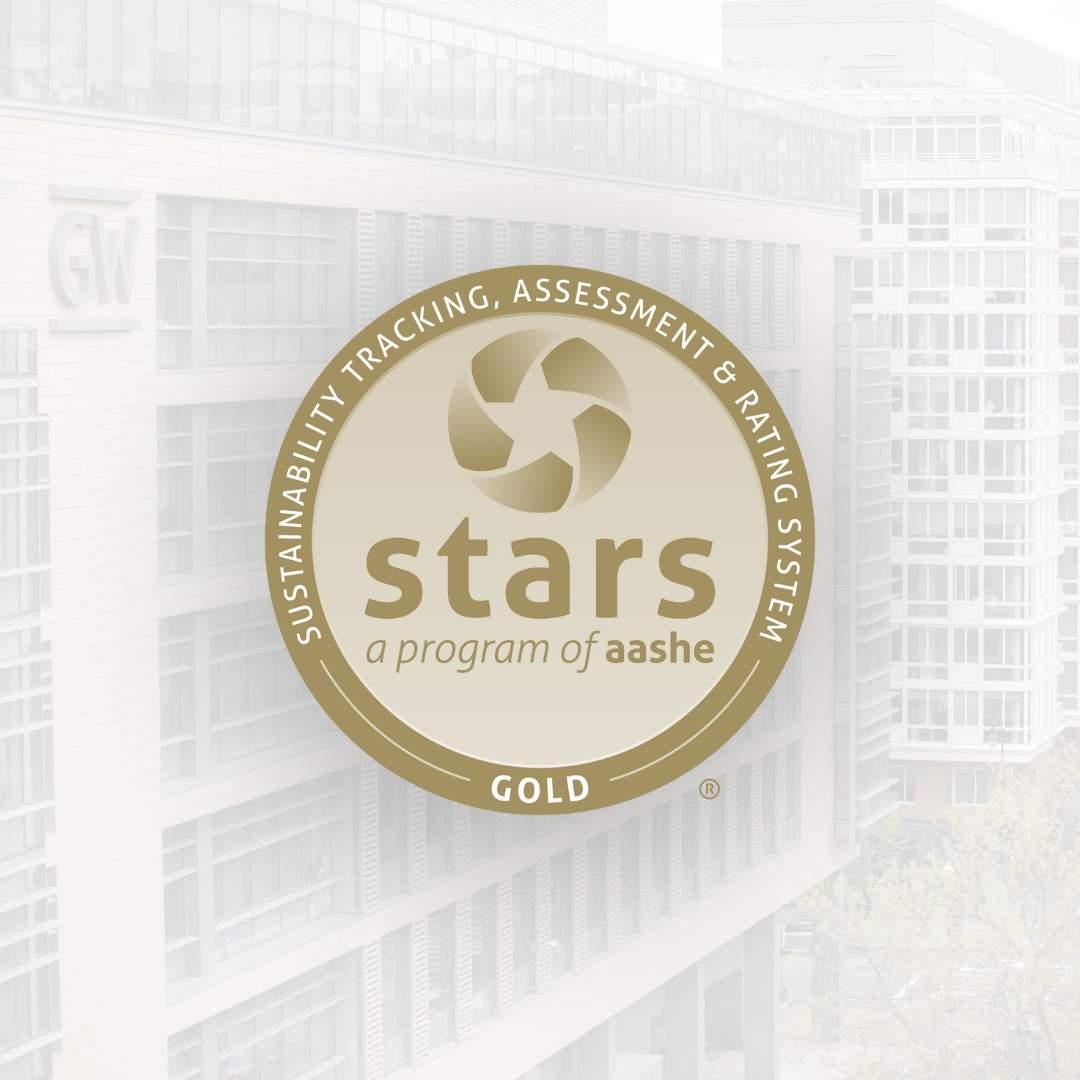
GW Pursues STARS Platinum
In 2024, the university launched the data collection effort for STARS in pursuit of GW’s Platinum rating in 2025, a board-level commitment made in 2020. The data collection effort follows 18 months of implementing specific, targeted changes to advance GW’s performance since the Gold rating earned in 2023. This included participation in 15 different graduate program orientation events as well as the inclusion of sustainability in GW's draft strategic framework.

Greenhouse Gas (GHG) Reporting
$0
of GW’s entire GHG emissions portfolio is made up of Scope 3 GW-sponsored and student study abroad travel combined
Scope 3 Emissions Produces the Largest Increase in GHG Emissions in 2024
While Scope 1 emissions experienced a decrease of roughly 1,584 MTCDE, Scope 2 increased by 1,223 MTCDE and Scope 3 increased by 6,942 MTCDE, making an overall net increase in total emissions from 2023. Medium to long-distance travel within Scope 3 emissions had the largest impact on our GHG emissions growth in 2024.
As of 2024, GW is approximately 15% of total emissions away from the 40% interim reduction target goal for 2025 from GW’s 2008 baseline emissions. The university is currently on track to meet that 40% reduction in 2025.

Fossil Fuel Divestment
$0
of GW’s endowment is made up of fossil fuel investments
In the summer of 2024, GW created a volunteer, faculty-led working group charged with providing actionable recommendations around a set of identified community challenges. Fossil fuel divestment was covered in this group, and to achieve its divestment goal, GW advanced the working group’s recommendation in the fall of 2024 to establish a committee to provide guidance on socially and environmentally responsible investment strategies.
By the end of 2024, fossil fuel investments continued to make up less than 2% of the endowment, and GW continues to be on track to fully divest from fossil fuels by 2025 to meet its divestment commitment. Further, GW has no history of making direct public investments in fossil fuel companies. Additionally, since 2013, GW has not made commitments to invest in private funds which focus on businesses that derive the majority of their revenues from the extraction of fossil fuels.
BUILT ENVIRONMENT

Renewable Energy
New Power Purchase Agreement Signed in 2024
At the end of 2024, GW executed an additional solar PPA for 49,000 MWh per year for 15 years at a fixed rate. This project complements the Capital Partners Solar Project PPA executed in 2015. When this new project comes online in 2026, this agreement will allow GW to source its electricity from 100% renewable sources.
GW’s Solar For All Rooftops Continue to Benefit the University and Community
GW hosts solar as a part of D.C. Department of Energy and Environment’s Solar for All program on five rooftops, including Funger and Duquès halls, the Charles E. Smith Center, Monroe Hall and Hall of Government, Lisner Auditorium and the Media and Public Affairs Building. The panels are designed to have a capacity of 497 kWAC, with the clean energy generated by the system reducing greenhouse gas emissions equivalent to removing roughly 90 cars from the road each year they operate. Not only does this program save money for GW’s energy expenses, it also benefits the greater community by donating a portion of the project’s revenue every year to low-income DC residents who require utility assistance. In 2024, based on GW’s energy production, approximately $90,000 should have been distributed by New Columbia Solar.

Energy Efficiency
$0
GW's Energy Use Intensity (EUI) Across Foggy Bottom
GW Sustainability Secures $1.5 Million to Decarbonize Foggy Bottom
Following a successful pilot decarbonization study in 2023, GW initiated an RFP process for building decarbonization planning services, with contractor onboarding to occur in early 2025, using $1.5M in capital funds secured for FY25, FY26, and FY27 following a successful request from President Granberg in November of 2023.
In 2024, GW is only 4 kBtu/sq. ft. away from its 241 EUI goal for 2026.
Southland Project Improves GW’s Energy Efficiency
The Southland Energy Project at GW has been improving GW’s energy efficiency. In 2024, they retrofitted most LED lighting and will add additional rooftop solar on buildings in 2025. This project also created an employment opportunity for a GW student intern.
Leadership in Energy and Environmental Design (LEED) Projects
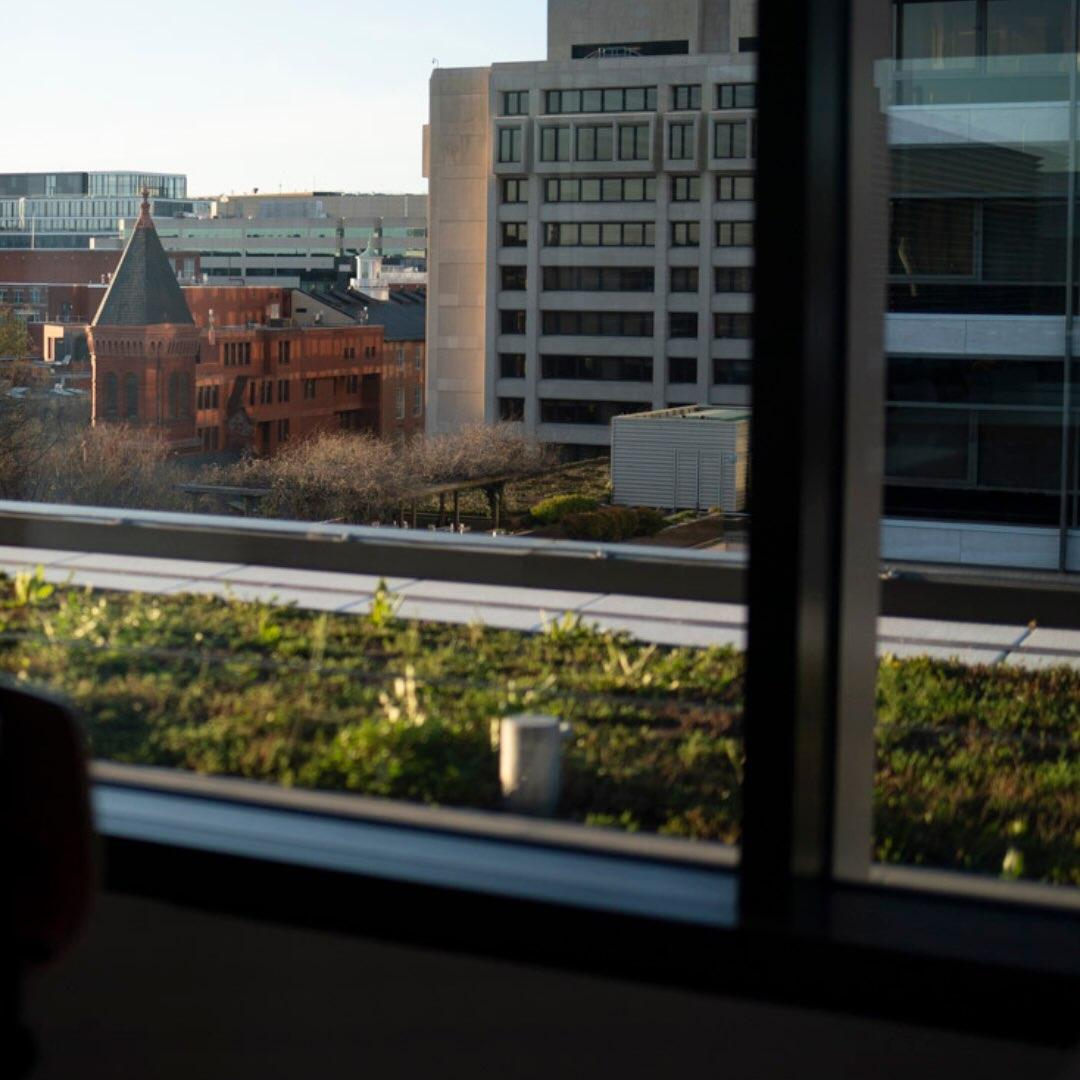
Thurston Hall Achieves LEED Platinum Certification and Reopens After Renovations
Thurston Hall spent its first year as a LEED Platinum-certified building after reopening in December 2023. It joins the Milken Institute of Public Health in its Platinum status, the highest LEED certification. The building is outfitted with, rainwater harvesting, a green roof, solar panels, LED lighting and heat pumps.
"Thurston Hall before and after renovation is like day and night for efficiency, design, and comfort."
Sonny
Assistant Director of Zone 4 Facilities, Buildings and Grounds
- GW LEED Projects
GW requires all new buildings and major renovations to be at least LEED Silver on Foggy Bottom and LEED Gold on the Mount Vernon Campus.
Gold
- Ames Hall (Mount Vernon Campus)
- Charles E. Smith Center
- Corcoran Hall
- District House/ Square 77
- GW Human Resources (2013 H St. NW)
- GW Textile Museum
- Jacob Burns Community Legal Clinics
- Lafayette Hall
- Ross Hall 5th & 6th Floors
- Science and Engineering Hall
- South Hall
- West Hall (Mount Vernon Campus)
Silver
- Administrative Offices (1922 F. St. NW)
- Conservation and Collections Resource Center (VSTC)
- G Street Garage and Law Learning Center

Water

GW Performed Water Balance Study, Finding Water Saving Opportunities
GW performed a water balance study revealing that roughly 40% of potable (drinkable) water consumed by the university goes to non-potable uses such as landscaping, cooling, and sewage. This represents a significant opportunity: GW could save up to $600,000 per year. Looking forward, additional focus and resources are required to implement recommended cost and water-saving strategies.
GW is also working to conserve water and increase water bill cost savings through rainwater toilets. In Thurston Hall, 161 toilets were installed during renovations increasing the amount of rainwater toilets to 294 on campus.

Transportation

GW Partners with Electric Avenue to Develop a Sustainable Transportation Strategy
GW Office of Sustainability partnered with Electric Avenue to develop a sustainable transportation strategy for the university, identifying more than 50 potential actions, projects and initiatives related to electric vehicles, charging infrastructure, micromobility, commuting, employee travel and more.

Nature-based Solutions

GW Revitalizes Square 80
GW Sustainability led the revitalization of Square 80, a certified Sustainable SITES project, including the installation of brand new signage to replace the original signage that was added nearly 15 years ago as well as the planting of new native and adapted species in various garden beds. They coordinated the repair of the on-site cistern to make the rainwater fountain operational once again.
In addition to reclaiming 24,000 square feet of green space, Square 80 features:
- Pervious paving throughout the walkways
- Rainwater harvesting through biofiltration planters, rain gardens, bioswales, and roof water collection. With these, the captured stormwater is used for plant water and to power the fountain

Additional Green Walls Installed
GW also planted three green walls in 2024 at South Hall, 2013 H Street, and Thurston Hall. The green walls will reduce the urban heat island effect and require minimal maintenance.
COMMUNITY
Eco-Reps
In 2024, led by student energy, Eco-Reps grew engagement across campus and connection with the Foggy Bottom community. They organized and hosted a steady stream of creative programming to engage new audiences, including a costume exchange, a pickling workshop, a pumpkin smash and regular tea times. They consciously worked to cover wide areas of sustainability to help students connect their passions with sustainability. Looking to 2025, Eco-Reps plans to continue hosting more skill-building workshops to foster students’ ability to live more sustainably.


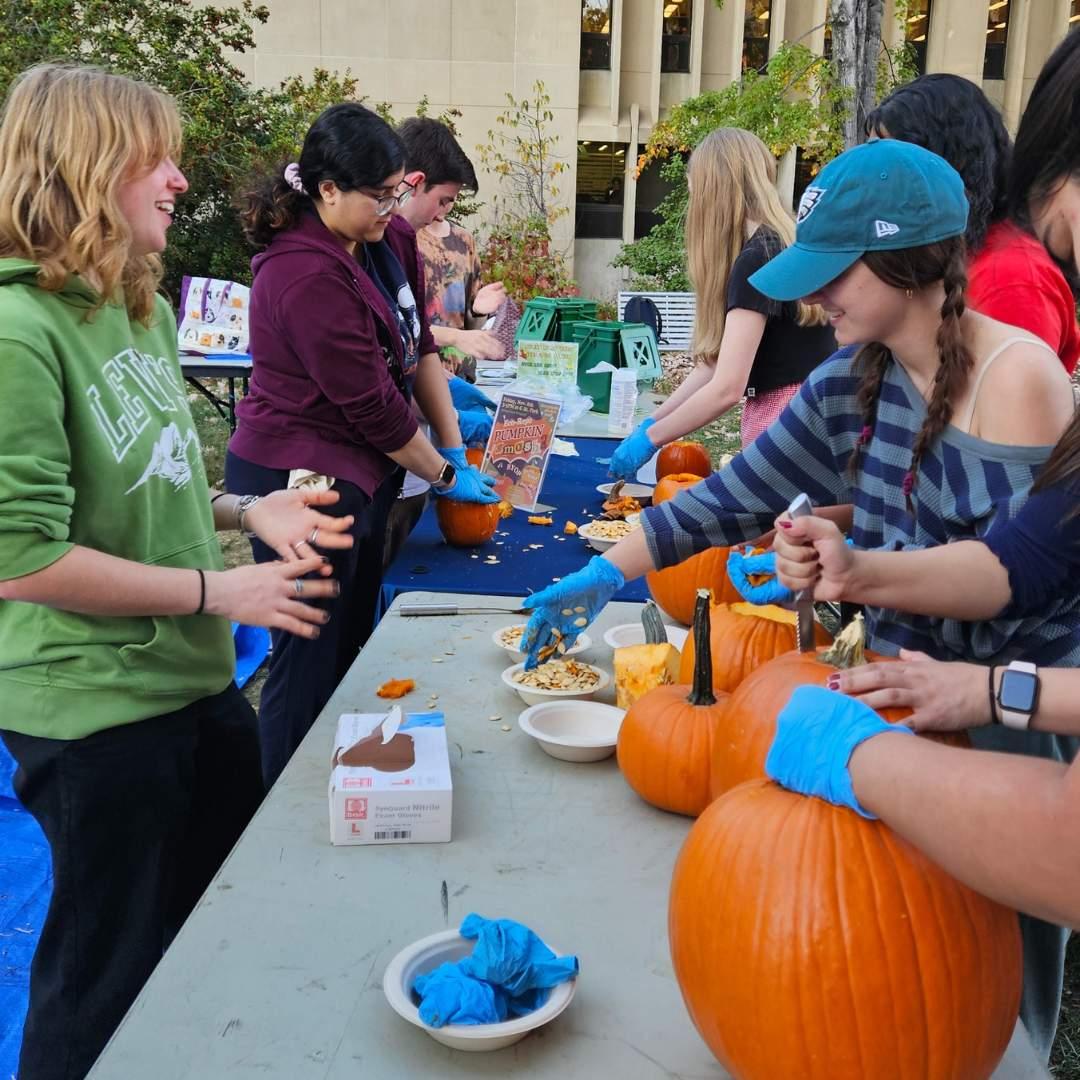

"What I love about Eco-Reps is how our events are a low barrier of entry to sustainability. There is always teaching along the way of the fun activities- like smashing pumpkins and learning about composting. Our events show students that it’s not difficult to adopt sustainable habits."
Addy
GW Sustainability Eco-Reps Intern
$0
Eco-Reps Members
$0
Attendees

Biweekly Tea-Times
"The Eco-Reps program offers students a space and community to engage with a variety of sustainability topics. Through Eco-Reps, students can get involved in workshops and events to cultivate sustainability habits and access resources to propose and develop projects that address specific sustainability challenges on campus."
Vidya M.
GW Sustainability Office Intern

GW Engaged 5,000 Students and Community Members Across Campus Through Earth Month Events
The Office of Sustainability curated and produced more than a dozen events as part of Earth Month 2024, including the soft launch of The Loop, the inaugural planting of the Mount Vernon Community Garden, a plant and pot exchange, a campus ecology tour, a panel on energy and environmental justice, reuse crafting activities, and much more. The office also held a living events calendar that promoted campus-wide Earth Month community events.
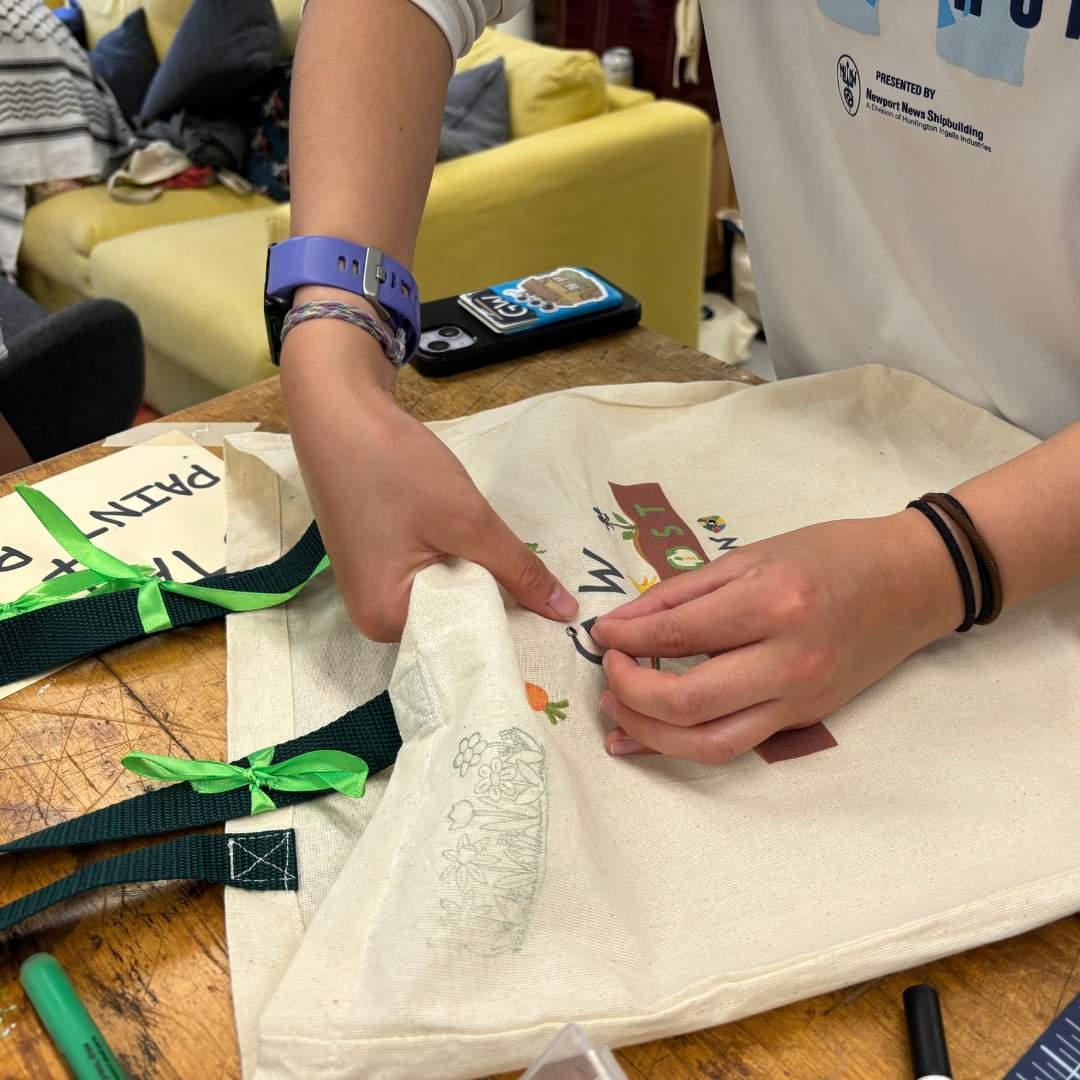

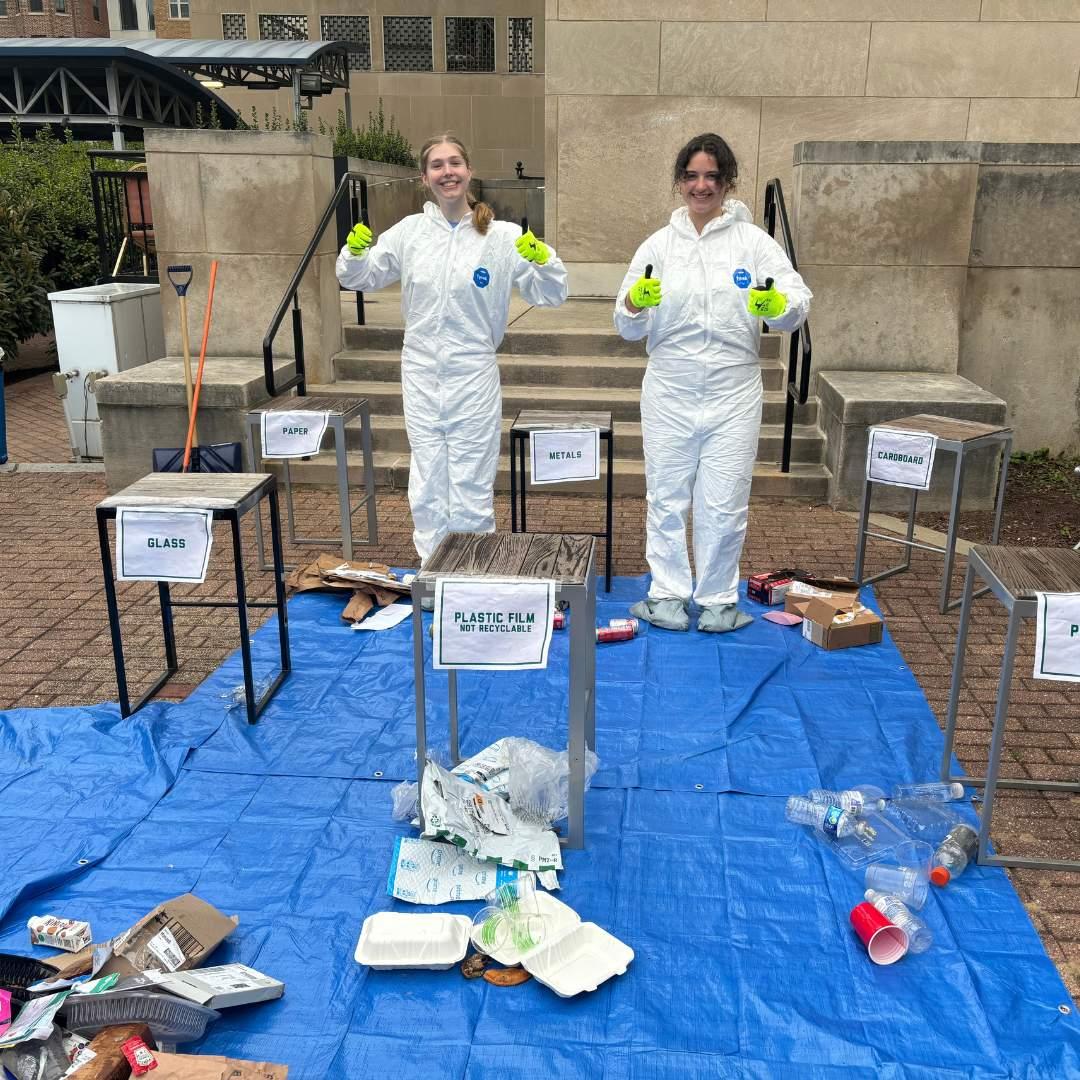
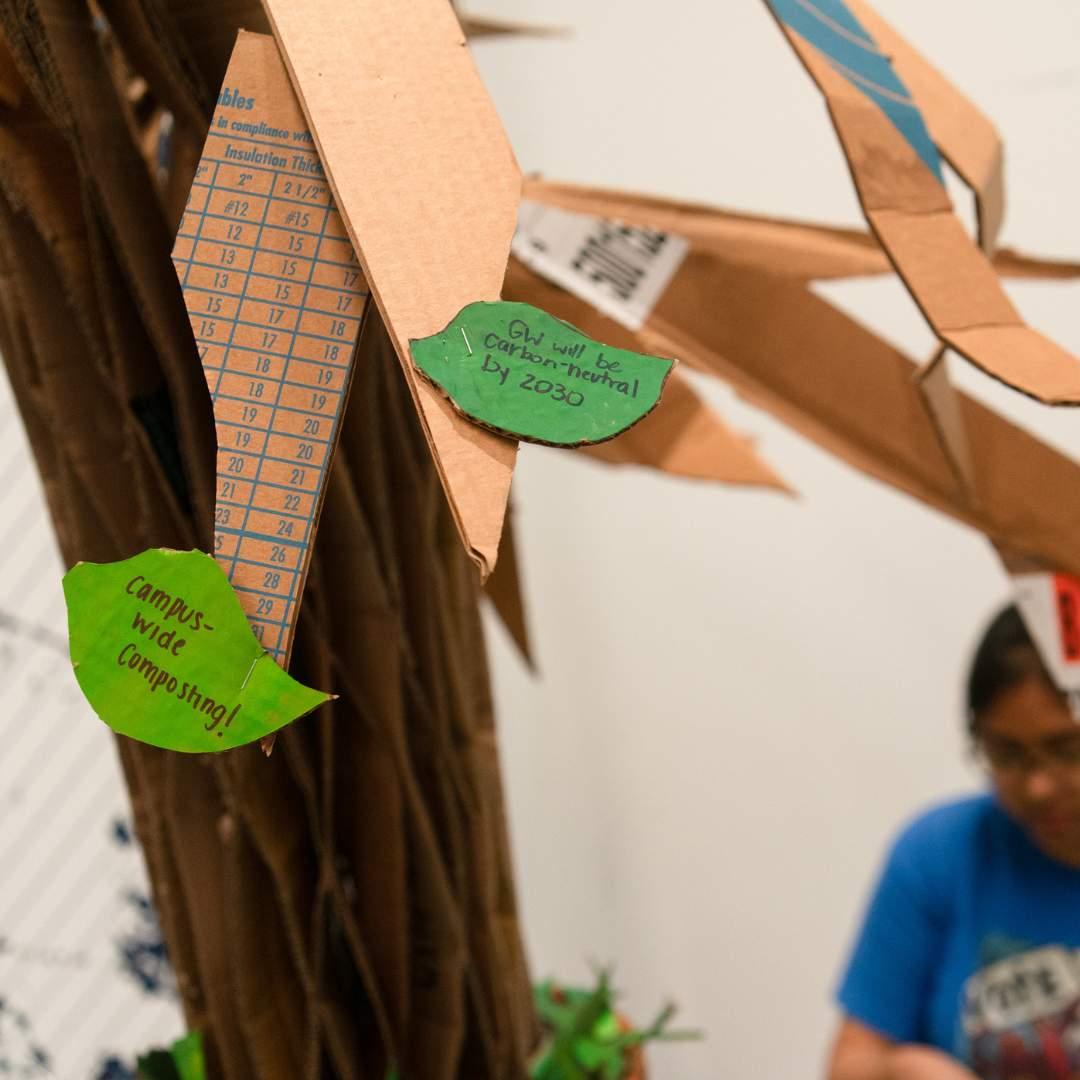
GW Furthered Sustainability Education Opportunities
The Office of Sustainability and GW’s Alliance for a Sustainable Future collaborated to launch the Sustainability Living-Learning Community (LLC). The community connects students through sustainability education, action, and engagement. This LLC will consist of approximately 20-30 students at the MVC campus and will be implemented in the fall of 2025. It will be open to any student interested in sustainability, with no requirement to participate in the minor program.
$0
Seats Filled in Sustainability Courses
$0
Sustainability Minor Students
GW’s Eco-Equity Challenge Continues
Through the Eco-Equity Challenge Program, students collaborate with community partners to design a local project addressing environmental and social justice issues.
In the 2023-2024 academic year, the project was ‘Leave No Trace of Clinical Research Waste,’ developed by student Riley Lima, which aimed to reduce clinical research waste by redirecting excess medical supplies from The GW Medical Faculty Associates and GW's Office of Clinical Research to free clinics in D.C., including Bread for the City and La Clínica del Pueblo. These supplies helped to support underserved, uninsured patients.
The 2024-2025 academic year project is ‘SewUP!,’ a workshop series and textile drive at the Latin American Youth Center (LAYC) focused on textile sustainability, upcycling, and community organizing to reduce waste led by Ruby Leonard. With the Eco-Equity grant, the program provides sewing machines and supplies to enhance LAYC’s art and sustainability offerings. By the end of the series, students will create a custom piece from recycled materials and organize a community event, such as a clothing drive or swap, to promote waste reduction and advocacy.

The Green Office Network Increased Connection Between Offices to Grow Participant Offices by 25% Over the Past Two Years
The Green Office Network (GON) has increased its emphasis on connecting staff to share sustainability skills and knowledge. Their meetings grew in frequency and quality of engagement through community-building events, such as four town hall sessions held in 2024. In 2025, the network plans to host more interactive events in partnership with other community or GW organizations, such as Eco-Reps.
ZERO-WASTE

Landfill Diversion Rate
GW led a campus-wide composting effort to divert more than 500,000 pounds of organic waste from the landfill in partnership with GW Dining, campus event organizers, and individual campus community members. The Office of Sustainability also piloted paper towel composting in two buildings with plans to expand to four additional buildings in early 2025.
$0
Of All Waste at GW Was Diverted from Landfill in 2024
$0
Increase in Landfill Diversion Rate from 2022, Which Was at 19%

The Loop

The Loop, GW’s Free Clothing Exchange, Launched With Thousands of Visitors and Pieces of Secondhand Clothing Shopped
In Fall 2024, the Office of Sustainability launched The Loop on the Mount Vernon Campus. In just 22 operating days, The Loop welcomed over 1,100 customers (and likely hundreds more visitors) who left with more than 2,600 pieces of second-hand clothing. During the fall 2024 semester, The Loop was also host to multiple community events, including GW’s Tiny Dorm Concert.
Not only is The Loop open to students, but it is also open to the greater GW community to shop for free. While its typical operational hours are 10-4 on Fridays, The Loop also provides special 24-7 access to individuals with immediate clothing needs. This includes students or community members experiencing financial or domestic hardships who would benefit from extended hours.
"Since its soft launch last April, The Loop has been a popular outlet for students to exchange clothes sustainably, a need-based resource, and a welcoming community space."
Ruth
Textile Reuse Intern

Green Move Out & Reuse Market
In 2024, Green Move Out and Reuse Market Drew Record Number of Community Partners and Collections for Reuse Market
The events successfully diverted over 8,500 pounds of items from landfills. GW hosted the second annual Reuse Market at University Yard, offering free clothes, dressers, vacuums, mirrors, and other household goods sourced from the Green Move Out at the end of the spring semester. Not only does the market encourage students to reuse secondhand items, it also helps support GW’s students with the greatest need for items by offering discreet priority access to those that are first-generation college students and/or recipients of Pell Grants. Additionally, a winter Green Move Out was introduced in December 2024, focusing on five residence halls and securing 1,500 pounds of clothing and household goods, which were donated to Goodwill.
Learn more about Green Move Out and Reuse Market


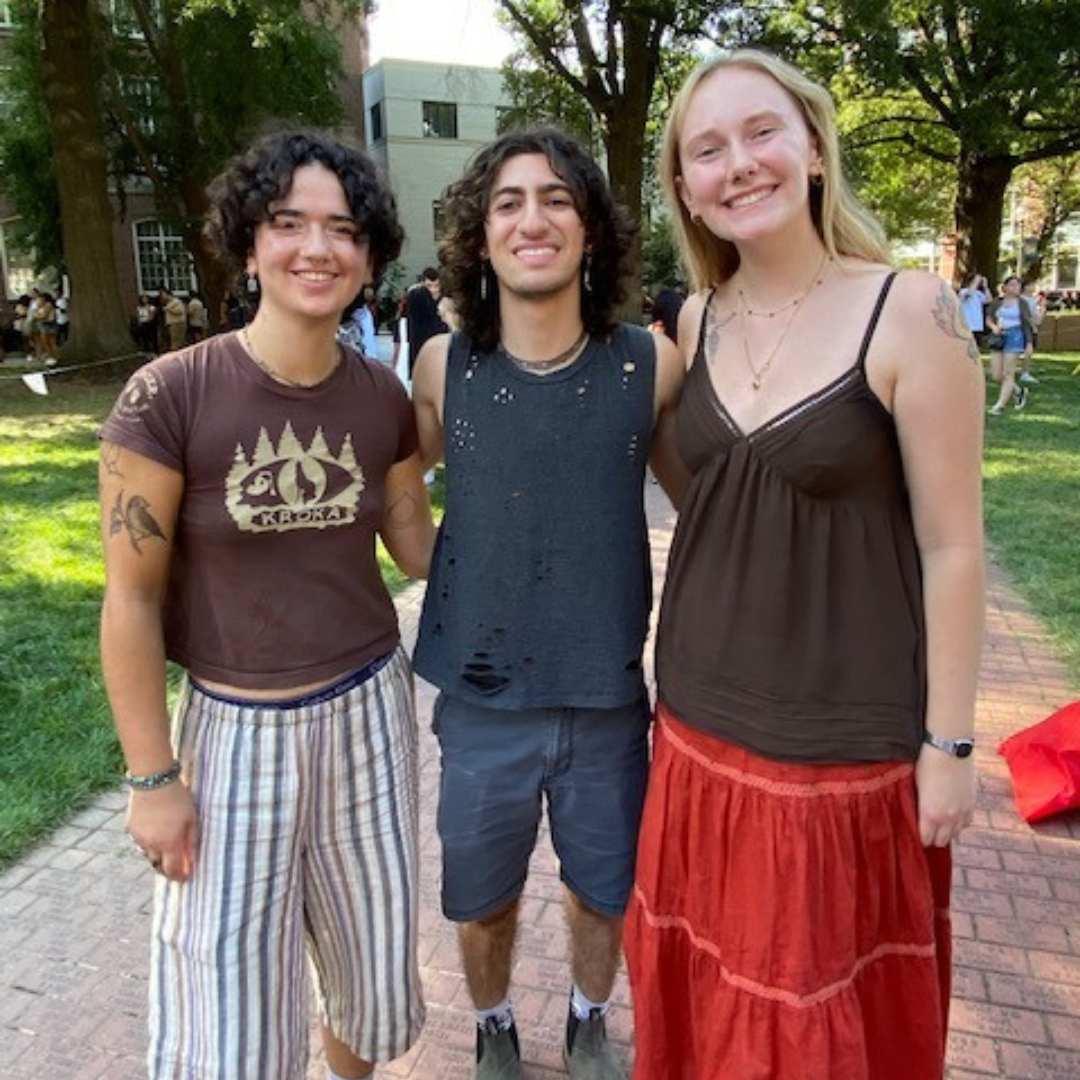

$0
Pounds of Clothing and Household Goods Diverted at First Winter Move-out
$0
Shoppers at the Reuse Market
$0
Green Move Out Volunteers
$0
Community Partners Including Goodwill and Bread for the City That Received Donations
"As a local nonprofit, Goodwill of Greater Washington (DC Goodwill) is proud to partner with the George Washington University community. Our collaboration focuses on promoting environmental sustainability while also supporting the economic well-being of residents in the greater Washington area. Donations from the GWU community help fund DC Goodwill's career training and education programs, enabling individuals to thrive. Positive change happens in the world when we do good together!"
Carolyn
Director of Communications & Community at Goodwill of Greater Washington

Food Systems

Dining
GW’s Dining Contractor, Chartwells Higher Ed, Reports for FY2024:
- 6% of food and beverages purchased are sustainably or ethically produced
- 27% of food and beverages spending is on plant-based food

Food Recovery Network
The Food Recovery Team led more than a dozen recoveries that redirected more than 1,000 pounds of food to community members in need and in search of meals, deepening relationships with GW Dining, the Store (GW’s student-run food pantry addressing student food insecurity), Charlie's Place (a non-denominational, anti-hunger, homeless ministry serving the District), and various staff offices.
"2024 was a very special year for FRN, we built a great rapport with Dining and Charlie’s Place staff from recovering food from Shenkman and numerous university events."
Lauren
Food Recovery Network

Community Gardens

Mount Vernon Campus Community Garden
Launched the Mount Vernon Campus Community Garden following more than a year of fundraising, partnership development, and design work. The garden revitalizes a highly visible green space at the entrance to the Mount Vernon campus, featuring five raised beds and terraced planting areas.

GroW Community Garden
The GroW Garden partners with Miriam’s Kitchen, a local non-profit focused on ending chronic homelessness in the District, to address produce needs and donated weekly harvests, including tomatoes, green beans, okra, basil, and more. In 2024, around 500 pounds of fresh produce were donated. The garden hosted volunteer hours three times a week and partnered regularly with student organizations. Looking to 2025, the garden is working to increase productivity output.
"It’s been rewarding to have the garden for students at the Mount Vernon Campus; bringing the GW community together to grow students' connection with nature, each other, and their food."
Kianna & Eva
MVC Garden Managers

Compost
473,894 pounds
of waste were diverted into compost by GW in 2024.
This greenhouse gas offset is equal to:
$0
Gallons of gas
$0
Miles driven
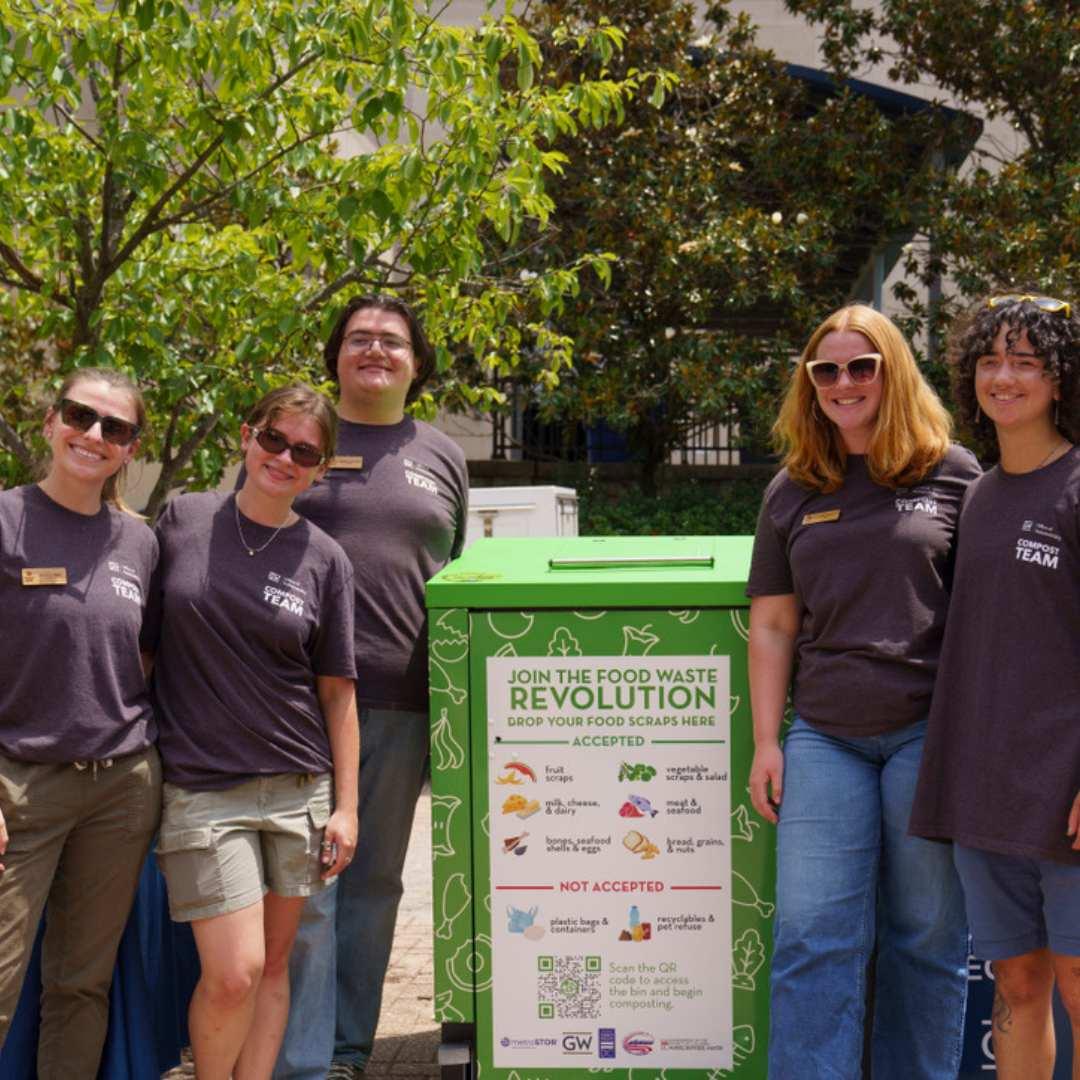
Smart Compost Bin
GW partnered with the DC Department of Public Works to install DC’s first smart compost bin on campus.
Through DPW’s purchase and hauling services, GW has the first of thirty MetroSTOR bins in DC. The bin helps the campus compost more easily while avoiding contamination and rodents. It is actively used, with an average of 190 pounds collected per week.
$0
Active Users
$0
Drop-offs
$0
Pounds of Organic Waste Diverted
"The Smart Compost Bin, endearingly named C.O.L.I.N. 'Composting Our Leftovers Into Nutrients,' has been a game changer for composting accessibility on campus. Composting went from designated times with student volunteers to 24/7. COLIN sits in a central, visible location that both students and DC area residents can access."
Jackson
Compost Educator Intern and Campus Sustainability Tour Guide

GW Sustainability Launches Paper Towel Composting on Campus
GW Sustainability started composting paper towels in the Support Building and Ross Hall in 2024 as a pilot for expanding the service to all administrative and academic buildings in 2025. To further reduce paper towel waste, science labs are transitioning using microfiber towels for cleaning in 2025.
.png)
